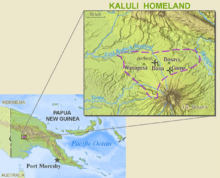Kaluli people
 Map of the Kaluli's territory |
The Kaluli are a clan of non-literate[1] indigenous peoples who live in the rain forests of Great Papuan Plateau in Papua New Guinea. The Kaluli, who numbered approximately 2000 people in 1987, are the most numerous and well documented by post-contact ethnographers and missionaries among the four language-clans of Bosavi kalu ("men of Bosavi") that together share a linguistic affiliation within the larger family of Non-Austronesian languages. Their numbers are thought to have declined precipitously following post-contact disease epidemics in the 1940s, and have not rebounded due high infant mortality rates and periodic influenza outbreaks.[2] The Kaluli are monolingual in their ergative language.[1]
The Kaluli live in longhouses, about twenty in number, which operate as autonomous communities. Each longhouse houses approximately fifteen families, numbering approximately 60 to 90 per longhouse,[1] that each divide into two or three patrilineal lineages. Many families have begun to live mainly in smaller separate dwellings for two or more extended families, while still maintaining their communal longhouse (circa 1984).[1] They are a highly egalitarian people without a hierarchical authority or ranked social structure. They are swidden agriculturalists whose food staple is the sago. They maintain extensive gardens while also pursuing hunting and fishing:[1] their diet is supplemented by garden cultivated banana, pandanus, breadfruit and green vegetables, as well as fish, small game, wild pig and occasionally domestic pig.[3] Kaluli people also believe that male initiation must be properly done by ritually delivering the semen of an elderly member through the initiate's anus.[4]
Language and Development
Everyday life of the Kaluli people has been characterized by ethnolinguists as overtly centered on verbal interaction (in comparison to middle-class Anglo cultures).[1] Spoken language is used as the primary explicit method of communicating desires, expression of thought, control and appeal. It is therefore the primary index of cultural competence. This is especially expressed in the socialization, or child-raising process, of infants to adults. For instance, when an infant first uses the words for "mother" and "breast", the behaviors oriented toward that child change: beforehand, a child is not considered to be capable of having specific intentions, whereas after this competence milestone the process of "teaching [the child] how to talk" begins, and thus talk begins to be directed directly at the child. This does not exist in middle-class Anglo cultures, where infants are addressed somewhat like intentioned competent individuals from birth through the use of baby-talk, which saliently does not exist in Kaluli culture. For this reason, the Kaluli language has been one of the languages invoked to describe the difficulty of meta-pragmatic-analysis in linguistics—in that many ethnographers, linguists, and anthropologists are biased towards their own culture—and to lobby for a more comparative approach.
See also
References
- 1 2 3 4 5 6 Language Acquisition and Socialization: Three Developmental Stories and Their Implications, from Linguistic Anthropology: a Reader, second edition by Duranti
- ↑ David Levinson, ed. (1996). Encyclopedia of World Cultures. 2, Oceania. G. K. Hall.
- ↑ Feld, Steven (1982). Sound and Sentiment: Birds, Weeping, Poetics, and Song in Kaluli Expression. Philadelphia: University of Pennsylvania Press. pp. 4–5.
- ↑ Henrich, Joseph (2010). "The weirdest people in the world?". Behavioral and Brain Sciences.